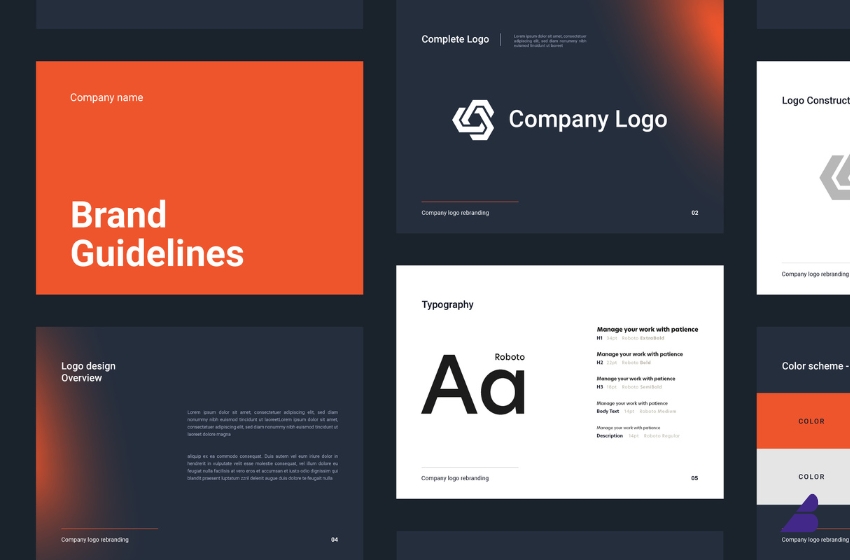
A brand manual, also known as brand guidelines, is no longer just about logos, colors, and fonts. In today’s fast-paced digital world, a brand manual needs to go beyond aesthetics—it must define the brand’s voice, values, and experience across all platforms.
Whether you’re building a new brand or refreshing an existing one, here’s what a modern brand manual should include.
1. The Brand’s Core Identity
Before diving into visual elements, a brand manual should define who you are and what you stand for.
✅ A. Brand Mission & Vision
✔ Mission Statement – What is your purpose? What problems do you solve?
✔ Vision Statement – Where is the brand headed? What impact will it create?
💡 Example: Nike’s mission is “to bring inspiration and innovation to every athlete in the world.”
✅ B. Brand Values
Define the core beliefs that drive decisions and shape interactions with customers.
✔ Are you innovative, sustainable, customer-first, ethical, luxury-focused?
✔ These values should reflect in content, campaigns, and business culture.
💡 Example: Patagonia’s values include environmental responsibility, reflected in its sustainable products.
✅ C. Target Audience & Personas
A modern brand manual should define who you are speaking to with detailed customer personas:
✔ Demographics (age, location, income, profession)
✔ Psychographics (values, lifestyle, interests)
✔ Pain points & solutions (How does your brand help them?)
💡 Example: A high-end skincare brand targets eco-conscious women aged 25-40 who prefer organic beauty products.
2. Visual Identity: Beyond Just the Logo
Your visual identity is more than just a logo—it’s about maintaining a consistent look and feel across all brand materials.
✅ A. Logo Usage & Variations
✔ Primary logo, secondary logo, and icon versions
✔ Correct & incorrect usage (sizing, spacing, background colors)
✔ Monochrome and alternative color versions
💡 Example: Apple uses a sleek monochrome logo, but the guidelines ensure its placement remains consistent across devices and campaigns.
✅ B. Color Palette
Define primary, secondary, and accent colors, with HEX, RGB, and CMYK codes for consistency across print and digital platforms.
💡 Example: Coca-Cola’s brand manual specifies the exact shade of red (PMS 484) to maintain its iconic look.
✅ C. Typography Guidelines
✔ Primary and secondary fonts for headings, body text, and callouts
✔ Acceptable font weights, sizes, and spacing rules
✔ Alternatives for web vs. print
💡 Example: Airbnb’s typography guide uses “Cereal” as its signature typeface for a modern, friendly look.
✅ D. Imagery & Photography Style
Define how images should reflect brand tone:
✔ Types of photography (lifestyle, candid, minimal, bold)
✔ Editing & filters (high contrast, muted tones, black & white)
✔ Stock image dos and don’ts
💡 Example: National Geographic’s brand guidelines ensure that images are always authentic, high-resolution, and storytelling-focused.
3. Verbal Identity: Brand Voice & Messaging
A brand’s voice is as important as its visuals. It determines how the brand sounds in ads, social media, website content, and even customer service interactions.
✅ A. Brand Voice & Tone
✔ Is your brand formal, friendly, witty, authoritative, or playful?
✔ Define DOs & DON’Ts for writing style and communication.
💡 Example: Mailchimp’s brand voice is casual yet professional, using humor while keeping a friendly and helpful tone.
✅ B. Key Messaging & Taglines
✔ Brand slogans and how they should be used
✔ Standard phrases for marketing and customer interactions
💡 Example: McDonald’s consistently uses “I’m Lovin’ It” across all branding materials.
✅ C. Social Media Guidelines
✔ Tone of voice for different platforms (LinkedIn vs. Instagram)
✔ Emoji and hashtag usage
✔ Community engagement policies (How to respond to comments & complaints)
💡 Example: Wendy’s brand voice on Twitter is fun, cheeky, and sarcastic, setting them apart from other fast-food chains.
4. Digital & Marketing Applications
Modern brand manuals must address digital platforms where the brand will appear.
✅ A. Website & UI Guidelines
✔ How branding should translate into the website design
✔ Button styles, color hierarchy, and typography rules
✔ Mobile responsiveness and accessibility requirements
💡 Example: Google’s Material Design provides clear guidelines for UI consistency across its products.
✅ B. Email Marketing & Newsletters
✔ Brand tone and formatting rules for newsletters
✔ Signature blocks, font guidelines, and CTA placements
✅ C. Advertising & Media Guidelines
✔ Ad format standards for Google Ads, Facebook, and Instagram
✔ Print vs. digital ad variations
💡 Example: Netflix maintains a uniform design in thumbnails and promotional banners to ensure instant brand recognition.
5. Internal & Brand Culture Guidelines
A brand manual should not only guide external marketing but also define internal culture and employee communication.
✅ A. Employee Branding & Internal Communication
✔ How employees should represent the brand in emails, social media, and events
✔ Guidelines for internal presentations, email signatures, and official documents
💡 Example: Apple has strict employee branding rules, ensuring all presentations match its sleek, minimalistic aesthetic.
✅ B. Partnership & Co-Branding Guidelines
✔ How third parties can use your brand assets
✔ Rules for sponsorships and collaborations
💡 Example: Adidas co-brands with artists and athletes but ensures that branding remains aligned with its core identity.
6. Accessibility & Inclusive Design
In 2025, brands must prioritize inclusivity and accessibility in all materials.
✔ Ensure color contrast for readability (great for visually impaired users)
✔ Use alt text for images in digital content
✔ Avoid gendered language or culturally insensitive visuals
💡 Example: Microsoft’s inclusive design principles ensure products are accessible to all users, regardless of abilities.
Final Thoughts: Your Brand Manual is Your Blueprint
A modern brand manual is more than a style guide—it’s a blueprint for how your brand looks, sounds, and feels across every interaction.
✔ It aligns employees, designers, and marketers on brand consistency.
✔ It builds trust, recognition, and credibility with your audience.
✔ It ensures that your brand evolves without losing its identity.
If your brand manual still only focuses on logos and colors, it’s time for an upgrade! 🚀




